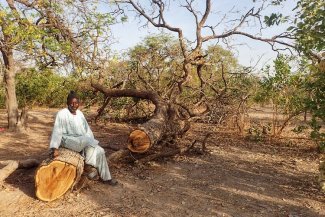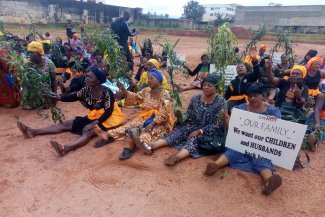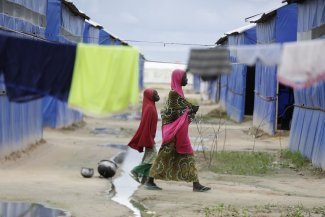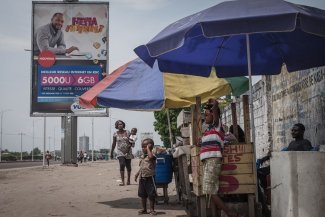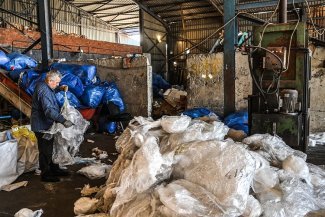A group of women returning from the fields in the Maradi region of Niger in August 2018.
While the Sahel remains plagued by recurrent conflicts, there are nonetheless positive signs of economic and social development in the countries of the region. Assessing these positive trends, as well as persistent vulnerabilities, is crucial to a better understanding of the region’s development and identifying the challenges ahead.
Sahelian countries are making clear progress on the human development front, as measured by the United Nations Human Development Index (HDI). The HDI has risen sharply in the Sahel since the 1990s, by an average of 1.9 per cent per year, three times higher than the global average.
The development indicators in this index include the health of populations, which in the Sahel has improved significantly: life expectancy at birth has increased from an average of 49 years in 1990 to 61 years in 2018.
Another component of the HDI is per capita income, which has also increased significantly (by about 67 per cent compared to 1990) while, in parallel, the extreme poverty rate has fallen (from 75 per cent in the 1990s to 41 per cent in 2018). The increase in wealth has therefore benefitted the poorest as well.
Despite this, the countries of the region are still poorly positioned in the latest HDI rankings (in the bottom 30 places for most of them). There is still work to be done therefore to strengthen the region’s very fragile health systems, in particular access to maternal health care, and to combat recurring undernourishment (which affects one person in five in the Sahel) and malnutrition (which affects one third of children under five).
The region continues to be made up of mainly low-income countries, however, where progress on the poverty front has been undermined by the effects of the Covid-19 crisis.
Major challenges remain in education and women’s empowerment
But it is above all on the education front that a major effort must still be made. Education indicators are considerably lower in the region: only one young person in two is literate (compared to an average of over three in four across Africa) and only one student in three completes secondary school.
Access to education – and more broadly to basic services – is a major issue in the region, in a context of strong demographic growth (+3 per cent per year), exacerbated by the fact that the increase in school enrolment rates has been accompanied by a decline in the quality of education.
The position of women in the economy should be strengthened. Although women are a vital force in the Sahel – playing a central role in food security and the resilience of societies – gender inequalities remain very marked and hamper women’s empowerment.
The region has the highest average fertility rate in the world (5.5 children per woman and 6.7 in Niger). As a result, the Sahel could see its population double within 25 years, which means that the authorities will have to make a greater effort to meet the growing needs of the population.
The Sahel is one of the most dynamic regions in Africa, but the structural transformation of its economies is slow.
Sahelian GDP quadrupled between 1990 and 2020, while over recent years the region has had one of the highest economic growth rates in Africa (around +4.8 per cent per year on average since 2010).
Several factors can explain this dynamic: the good performance of certain key sectors and favourable rainfall, high investment and catch-up effects in certain sectors, the rise in the price of extractive commodities that are important for the region (such as gold), the existence of areas that are less exposed to security issues, and a moderate level of debt (56 per cent of GDP in 2020 compared to 66 per cent for Africa as a whole).
Despite this, the structure of the Sahelian economies has changed little since the 1990s. The service sector continues to account for almost half of value added and industry for less than a quarter. The agricultural sector, on the other hand, remains essential, accounting for around 30 per cent of value added since the 1990s and employing more than one in two Sahelians on average.
The development of agriculture is therefore crucial in order to meet the major challenges of the region: the economic challenge of diversification and economic transformation, the food challenge in a context of strong demographic growth, the social challenge in territories where social fragility and poverty require job creation and value-addition, and the environmental challenge.
Given this context, the Sahelian countries remain highly dependent on the outside world. As the export base of these countries is weak and import needs are high, the countries of the region have significant current account deficits (around 8 per cent of GDP on average in 2017-2019).
To cover these deficits, mobilising external support is crucial. The Sahel is the region of Africa that receives the most public development aid relative to GDP (7 per cent on average), and transfers from the diaspora are consistently high (6 per cent of GDP). The weakness of foreign direct investment, on the other hand (less than 4 per cent of GDP), unsurprisingly reflects an environment that is not conducive to business.
Conflicts: the great challenge of governance
The Sahel has been plagued by recurrent conflicts since 2012, with devastating human, political, economic and social consequences.
Conflicts also put pressure on public finances, due to the reduction of the tax base and the increase in military expenditure (almost 9 per cent of total expenditure, the highest level in Africa). Above all, the increase in military spending is at the expense of social and development spending, which further accentuates the negative economic impact of the conflicts.
In addition to the economic and social difficulties faced by the Sahelian populations, these conflicts are largely the result of the inadequate presence of the state in whole areas of the territory. The capacity of the Sahelian states to provide basic public services and control their territories is very limited overall.
The number of government employees per head of population is between 3 and 10 per 1,000 in Chad, Burkina Faso, Senegal, Mali and Niger, compared to 160 in Norway, for example. This is why measures to strengthen governance are of fundamental importance.
The dynamics at work in the Sahel and the progress made in development show that the region cannot be reduced to a single crisis zone. But to enable the countries of the region to achieve sustainable peace and development, at least five levers of action seem to be a priority: preventing and containing violent conflicts; improving governance; empowering women and girls; supporting youth; and supporting the restructuring of agricultural sectors and the development of the private sector and entrepreneurship.





